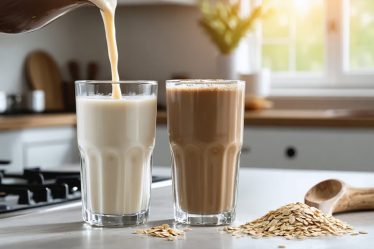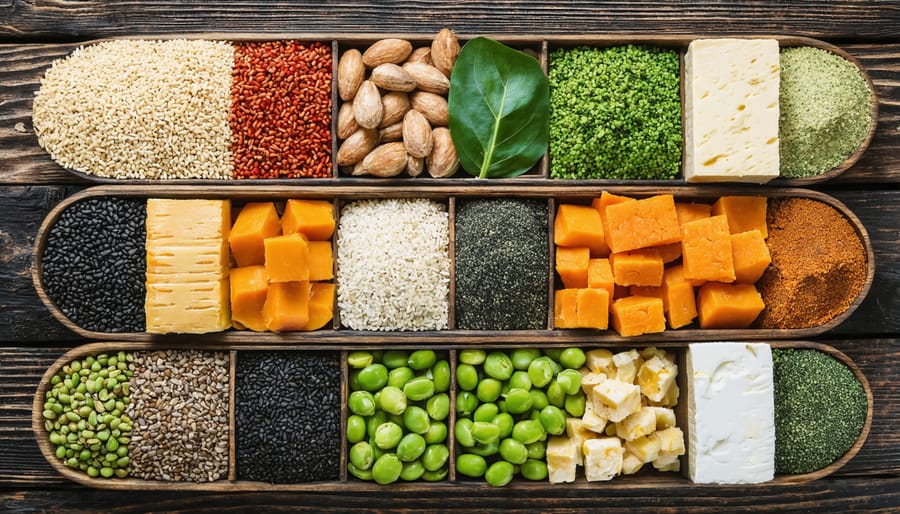
Mastering your protein intake goes far beyond counting grams – it’s about understanding the building blocks that fuel your body’s essential functions. These nine essential amino acids, which your body can’t produce on its own, are the key players in everything from muscle repair to immune system strength. While animal products traditionally take center stage in protein discussions, discovering the power of plant-based lifestyle benefits has revolutionized how we think about complete protein sources.
Whether you’re an athlete, busy professional, or health-conscious individual, understanding these crucial compounds – histidine, isoleucine, leucine, lysine, methionine, phenylalanine, threonine, tryptophan, and valine – opens up a world of dietary possibilities. From quinoa’s complete protein profile to strategic food combining, getting all nine essential amino acids is both simpler and more flexible than you might think.
Let’s explore how these vital nutrients work together to support your health goals, and discover delicious ways to ensure you’re getting everything your body needs – regardless of your dietary preferences or lifestyle choices.
Understanding the 9 Essential Amino Acids
What Makes These Amino Acids ‘Essential’?
Think of your body as an amazing factory that’s constantly building and repairing itself. While it can produce many of the amino acids it needs, there are nine special ones that your body simply can’t manufacture on its own. That’s where personalized nutrition science comes in, helping us understand why these particular amino acids are so crucial.
These nine amino acids are called “essential” because we must get them from our food – our bodies have no backup plan for creating them internally. They’re like crucial puzzle pieces that complete important biological processes, from building strong muscles to supporting your immune system and keeping your mood balanced.
Just as you can’t build a house without all the necessary materials, your body can’t perform its vital functions without these essential amino acids. They work together in perfect harmony, each playing a unique role in maintaining your health and vitality. That’s why it’s so important to ensure your daily diet includes foods rich in these vital nutrients, whether you’re following a plant-based or omnivorous eating pattern.
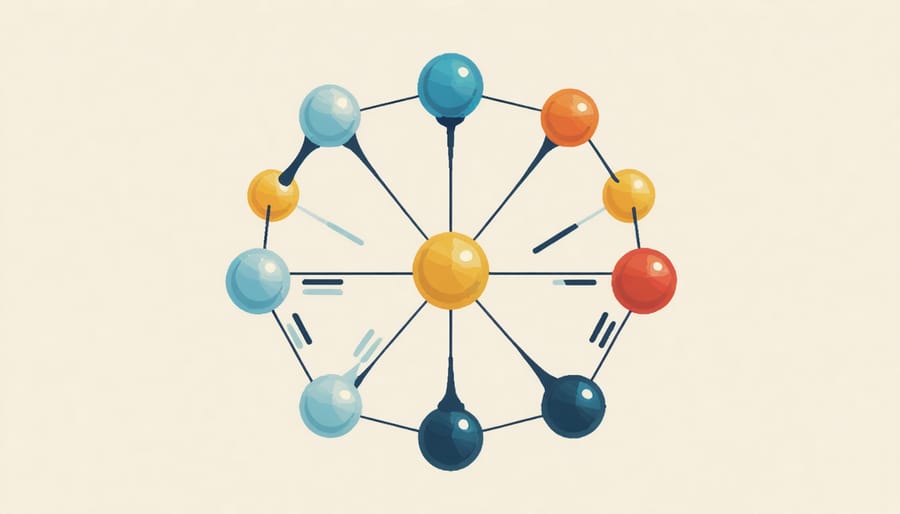
The Complete List: From Histidine to Valine
Let’s take a delightful journey through these nine powerhouse amino acids that our bodies can’t make on their own. Think of them as the VIP guests at your body’s daily health party!
Histidine is your body’s repair specialist, helping with tissue repair and creating those important blood cells. It’s also a mood booster, supporting your mental well-being throughout the day.
Isoleucine is like your personal energy manager, helping regulate blood sugar and providing fuel for your muscles. As someone who loves morning workouts, I especially appreciate how it helps with post-exercise recovery.
Leucine is the muscle maven – it’s essential for building and maintaining those lean muscles we work so hard for in our fitness routines. It’s also a great supporter of healthy bone strength.
Lysine is your skin’s best friend, helping create collagen for that natural glow we all love. It also supports your immune system and helps maintain healthy energy levels.
Methionine works behind the scenes, supporting your liver and keeping your hair shiny and strong. It’s also crucial for detoxification – think of it as your body’s cleanup crew!
Phenylalanine is your feel-good amino acid, helping create those happiness hormones that keep you smiling. It also supports healthy thyroid function.
Threonine supports your digestive health and helps maintain strong teeth and elastic skin. It’s like having a beauty treatment from the inside out!
Tryptophan (yes, the one from Thanksgiving turkey!) helps you get quality sleep and maintains a balanced mood. It’s your natural relaxation supporter.
Valine rounds out our list as another muscle-supporting superstar, helping with tissue repair and maintaining proper mental focus throughout your busy day.
Remember, getting these amino acids through your diet doesn’t have to be complicated – it’s about making informed choices and enjoying a variety of nutritious foods!
Plant-Based Sources Rich in Essential Amino Acids
Complete Plant Protein Sources
Gone are the days when we thought complete proteins could only come from animal sources! Let me share some exciting plant-based options that pack all nine essential amino acids into one delicious package. As someone who loves experimenting with plant-based cooking, I’ve discovered these nutritional powerhouses that make getting complete proteins a breeze.
Quinoa leads the pack as a versatile grain-like seed that’s perfect in salads, buddha bowls, or as a rice replacement. I love how it takes on any flavor while delivering all the amino acids we need. Buckwheat, another pseudo-grain, is equally impressive and makes wonderful pancakes or Japanese soba noodles.
Soy-based foods like tempeh, tofu, and edamame are complete protein champions. Tempeh’s nutty flavor has become a favorite in my stir-fries, while edamame makes the perfect protein-rich snack. Hemp seeds are another fantastic option – I sprinkle them on everything from smoothie bowls to salads for an instant protein boost.
Here’s a lesser-known gem: spirulina, a blue-green algae that’s incredibly nutrient-dense. Just a tablespoon in your morning smoothie provides a complete amino acid profile. And don’t forget about chia seeds – these tiny powerhouses aren’t just trendy, they’re nutritional goldmines that work wonderfully in puddings, baked goods, or as egg replacements.
Remember, these foods make it simple to meet your protein needs while enjoying delicious, plant-based meals!
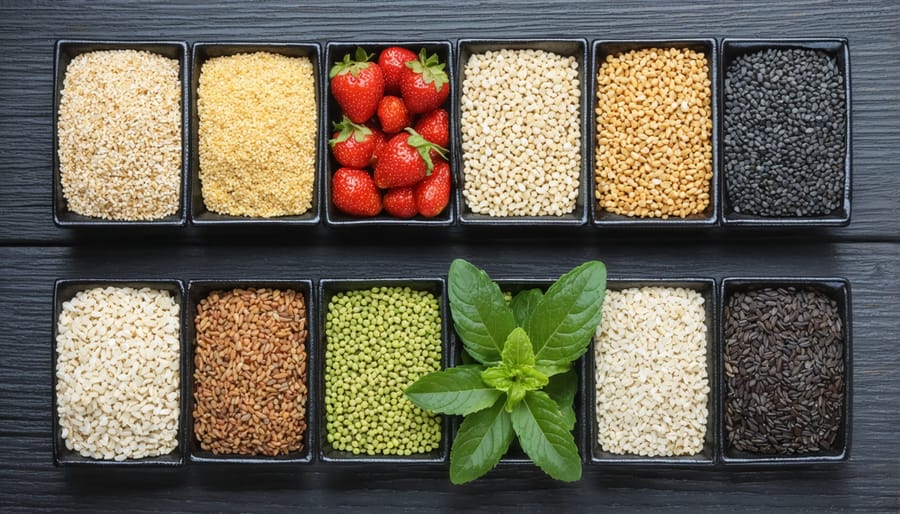
Complementary Protein Combinations
Creating complete protein combinations doesn’t have to be complicated! As someone who loves experimenting in the kitchen, I’ve discovered that mixing and matching plant-based proteins can be both fun and delicious. The key is pairing foods that complement each other’s amino acid profiles.
Some classic combinations that work beautifully together include rice and beans (a staple in many cultures for good reason!), hummus and whole grain pita, and quinoa with lentils. Think of these pairings as dance partners – they bring out the best in each other!
Here are some of my favorite protein-perfect matches:
• Whole grain toast + peanut butter
• Black beans + corn tortillas
• Lentil soup + brown rice
• Chickpea curry + basmati rice
• Oatmeal + almonds
The best part? You don’t need to eat these combinations at the same meal – your body is smart enough to combine amino acids from foods eaten throughout the day. If you’re looking for inspiration, check out these delicious plant-based recipe ideas that naturally incorporate complementary proteins.
Remember, variety is your friend! Mix different legumes, whole grains, nuts, and seeds throughout your weekly meal plan to ensure you’re getting all the essential amino acids your body needs. Keep it simple, keep it tasty, and most importantly, enjoy exploring these nourishing combinations!
Smart Food Pairing Tips
Creating balanced meals with complete amino acid profiles doesn’t have to be complicated! I’ve found that some of the best food combinations are actually traditional pairings we’ve been enjoying for generations. Take rice and beans, for example – this classic combo isn’t just delicious, it’s nutritionally genius!
Here are some foolproof pairings I love to recommend:
– Quinoa with black beans in a vibrant Mexican-inspired bowl
– Whole grain toast topped with creamy hummus
– Brown rice and lentil curry with a side of roasted vegetables
– Pita bread dipped in smooth peanut butter for a quick snack
– Corn tortillas filled with refried beans and fresh salsa
The key is thinking about your plate in terms of complementary proteins. When you combine grains with legumes, or nuts with whole grains, you’re creating complete protein powerhouses. I like to prep a big batch of quinoa and different beans at the start of the week, making it super easy to throw together balanced meals on busy days.
Remember, you don’t need to combine these foods at every single meal. As long as you’re eating a variety of protein-rich foods throughout the day, your body will get all nine essential amino acids it needs. Keep it simple, keep it tasty, and most importantly, make it work for your lifestyle!
Simple Meal Ideas for Complete Plant Proteins
Breakfast Combinations
Starting your day with the right protein combination sets a positive tone for your nutritional goals. One of my favorite morning power duos is whole grain toast topped with creamy hummus – the bread and chickpeas work together to create a complete protein profile. For a sweeter option, try overnight oats made with soy milk and topped with a sprinkle of nuts and seeds.
If you’re craving something warm and comforting, quinoa breakfast bowls are a fantastic choice. Quinoa is one of the few plant foods that contains all nine essential amino acids on its own. Jazz it up with almond butter, fresh fruits, and a dash of cinnamon for a nourishing morning meal.
For those busy mornings, blend up a protein-packed smoothie with plant-based milk, banana, and a mix of hemp and chia seeds. I love adding a handful of spinach for an extra nutrient boost – you won’t even taste it! Remember, combining different protein sources in your breakfast not only ensures you’re getting all essential amino acids but also adds exciting flavors and textures to start your day.
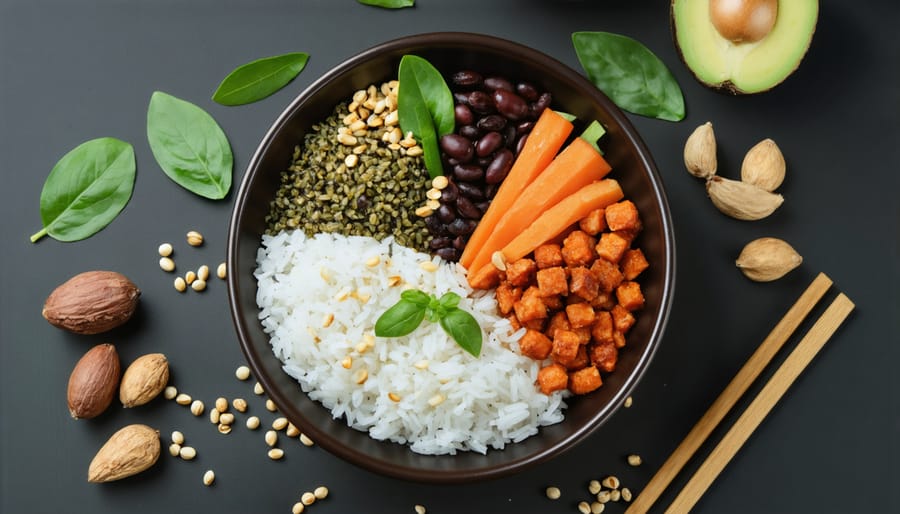
Lunch and Dinner Solutions
Creating balanced meals that include all nine essential amino acids doesn’t have to be complicated! I’ve found that thinking in terms of complementary proteins makes lunch and dinner planning so much easier. For example, pairing rice with beans or lentils creates a complete protein powerhouse that’s both satisfying and nutritious.
Some of my favorite lunch combinations include quinoa Buddha bowls topped with roasted chickpeas, hearty lentil soup with whole grain bread, or a wrap filled with hummus and mixed vegetables. These options are perfect for meal prep strategies and can be prepared in advance for busy weekdays.
For dinner, try combining tempeh or tofu with brown rice and steamed vegetables, or make a colorful stir-fry with edamame, mixed vegetables, and noodles. Mediterranean-inspired dishes like falafel with whole wheat pita and tahini sauce also provide an excellent amino acid profile.
Remember to include a variety of protein sources throughout your day rather than stressing about getting all nine amino acids in a single meal. Your body maintains an amino acid pool that it can draw from over time. This flexible approach makes it easier to enjoy diverse, delicious meals while meeting your protein needs naturally.
Snack Ideas
Need a quick protein boost? I’ve got some delicious snack combos that’ll give you all nine essential amino acids in one go! One of my favorites is apple slices with almond butter – I love drizzling a bit of honey on top for extra sweetness. Another winning combination is hummus with whole-grain crackers, perfect for those afternoon cravings.
For something more substantial, try mixing Greek yogurt with berries and a sprinkle of pumpkin seeds. If you’re meal prepping, prepare small containers of quinoa salad with chickpeas, cucumber, and a lemony dressing – it stays fresh for days! Trail mix made with nuts, seeds, and dried fruits is perfect for on-the-go snacking.
Here’s a fun one I discovered recently: roasted chickpeas with your favorite seasonings paired with a handful of pistachios. For something different, try rice cakes topped with mashed avocado and hemp seeds. These combos aren’t just delicious – they’re designed to give your body the complete protein it needs while keeping things interesting and satisfying.
Remember, the key is combining different protein sources to ensure you’re getting all nine essential amino acids in your snacks!
As we’ve explored throughout this article, getting all nine essential amino acids doesn’t have to be complicated – even if you’re following a plant-based diet. The key is variety and mindful combination of different protein sources. By mixing and matching foods like quinoa, lentils, chickpeas, and whole grains, you can easily create delicious meals that provide all the amino acids your body needs.
Remember that you don’t need to achieve a perfect amino acid balance at every single meal. Your body is remarkably adaptable and can maintain its amino acid pool throughout the day. This means you can focus on enjoying diverse, nutrient-rich foods across your meals rather than stressing about precise combinations.
I’ve personally found that meal prepping with a variety of plant proteins has made it easier to maintain a balanced diet. One of my favorite go-to combinations is a Buddha bowl with quinoa, roasted chickpeas, and steamed edamame – it’s not only protein-complete but also absolutely delicious!
Why not start experimenting with your own protein-rich combinations? Try adding hemp seeds to your morning smoothie, sprinkling nutritional yeast on your lunch salad, or creating dinner bowls with different legumes and grains. The possibilities are endless, and you might discover new favorite meals along the way.
Remember, whether you’re fully plant-based or simply looking to include more plant proteins in your diet, focusing on these nine essential amino acids can help you maintain optimal health while enjoying a diverse and flavorful array of foods. Your journey to protein-complete meals can be both nutritious and delicious!



